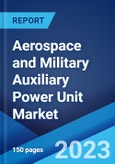An aerospace and military auxiliary power unit (APU) is a device that provides electrical power to the electrical systems on an aircraft. It relies on the aircraft battery to operate and is generally located in the tail cone, engine nacelle, or wheel well in different aircraft types. It allows an aircraft to operate autonomously without the need for ground support equipment, such as a ground power unit, an external air-conditioning unit, or a high-pressure air start cart. It aids in offering pneumatic energy until the aircraft reaches a certain height. Besides this, it assists in providing reliable performance and reducing fuel consumption and maintenance costs of aircraft. As it is beneficial in emergency situations like engine failure to provide electrical power, the demand for aerospace and military APU is rising across the globe.
Aerospace and Military Auxiliary Power Unit (APU) Market Trends:
At present, the rising demand for APUs due to the inflating income levels and consequently increasing number of people traveling to different places represents one of the primary factors contributing to the growth of the market. Apart from this, the growing utilization of APUs in the electric aircraft to reduce carbon emissions is offering a favorable market outlook. Additionally, their rising adoption for additional power in aircraft is impelling the growth of the market. Besides this, the growing employment of APUs in aircraft due to the increasing number of cargo operations that carry goods efficiently from one place to another is positively influencing the market. In addition, the rising need to reduce fuel consumption in the aerospace and military sector is bolstering the growth of the market. Moreover, the increasing deployment of APUs in military aviation due to the rising defense expenditure, along with the upgradation of old military aircraft, is offering lucrative growth opportunities to industry players. In line with this, the increasing demand for military aircraft on account of the rising number of terrorist activities around the world is supporting the market growth. Furthermore, key players are introducing low-noise APUs for silent military operations and reducing noise pollution, which is strengthening the growth of the market.Key Market Segmentation:
The publisher provides an analysis of the key trends in each segment of the global aerospace and military auxiliary power unit (APU) market, along with forecasts at the global, regional, and country levels from 2025-2033. Our report has categorized the market based on application.Application Insights:
- Commercial Aircraft
- Narrow Body Aircraft
- Very Large Aircraft
- Wide Body Aircraft
- Military Aircraft
- Fighter Jet
- Unmanned Aerial Aircraft
- Military Land Vehicle
- Armored Vehicles
- Main Battle Tank
- Rotary Copter
- Civil
- Military
Regional Insights:
- North America
- United States
- Canada
- Asia Pacific
- China
- Japan
- India
- South Korea
- Australia
- Indonesia
- Others
- Europe
- Germany
- France
- United Kingdom
- Italy
- Spain
- Russia
- Others
- Latin America
- Brazil
- Mexico
- Others
- Middle East and Africa
Competitive Landscape:
The report has also provided a comprehensive analysis of the competitive landscape in the global aerospace and military auxiliary power unit (APU) market. Detailed profiles of all major companies have been provided. Some of the companies covered include Elbit Systems Ltd., Honeywell International Inc., Marvin Engineering Co. Inc., Raytheon Technologies Corporation, Safran S.A., The Dewey Electronics Corporation, etc. Kindly note that this only represents a partial list of companies, and the complete list has been provided in the report.Key Questions Answered in This Report:
- How has the global aerospace and military auxiliary power unit (APU) market performed so far, and how will it perform in the coming years?
- What are the drivers, restraints, and opportunities in the global aerospace and military auxiliary power unit (APU) market?
- What is the impact of each driver, restraint, and opportunity on the global aerospace and military auxiliary power unit (APU) market?
- What are the key regional markets?
- Which countries represent the most attractive aerospace and military auxiliary power unit (APU) market?
- What is the breakup of the market based on the application?
- Which is the most attractive application in the aerospace and military auxiliary power unit (APU) market?
- What is the competitive structure of the global aerospace and military auxiliary power unit (APU) market?
- Who are the key players/companies in the global aerospace and military auxiliary power unit (APU) market?
Table of Contents
Companies Mentioned
- Elbit Systems Ltd.
- Honeywell International Inc.
- Marvin Engineering Co. Inc.
- Raytheon Technologies Corporation
- Safran S.A.
- The Dewey Electronics Corporation
Methodology

LOADING...
Table Information
| Report Attribute | Details |
|---|---|
| No. of Pages | 149 |
| Published | March 2025 |
| Forecast Period | 2024 - 2033 |
| Estimated Market Value ( USD | $ 4.2 Billion |
| Forecasted Market Value ( USD | $ 5.6 Billion |
| Compound Annual Growth Rate | 3.2% |
| Regions Covered | Global |
| No. of Companies Mentioned | 6 |









